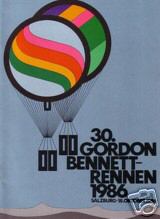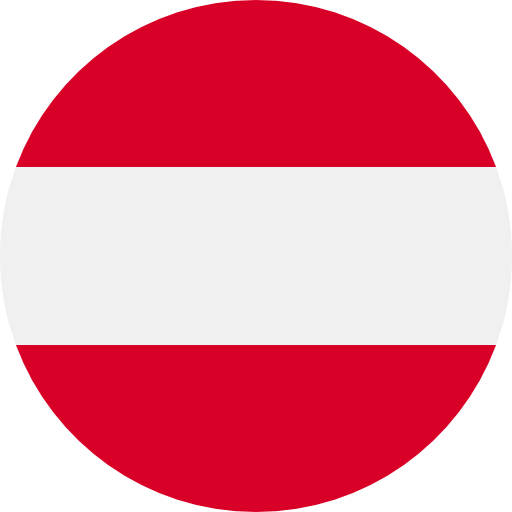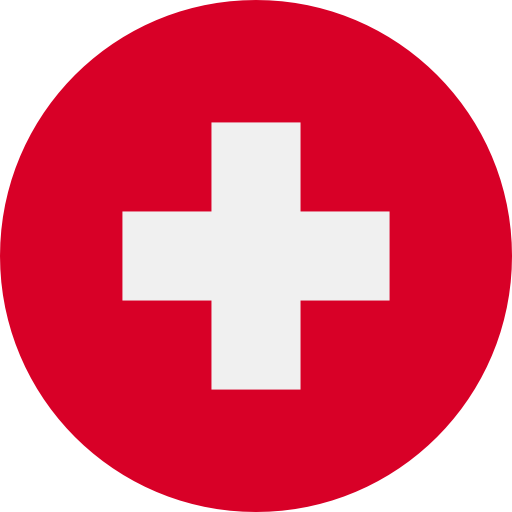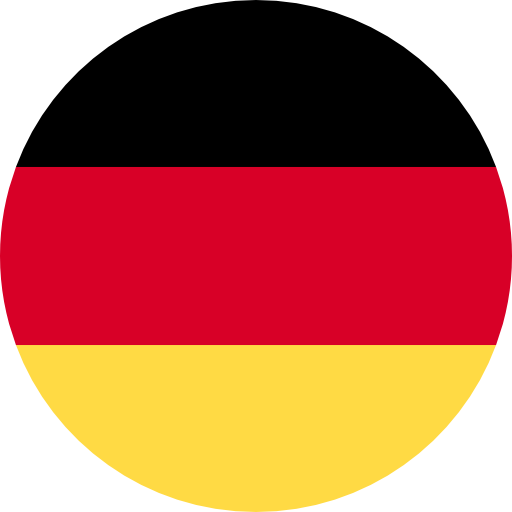30th Coupe Aéronautique Gordon Bennett
Salzburg, Austria, October 18, 1986

Results
| Rank | Pilots | Country | Score | Duration | Landing |
|---|---|---|---|---|---|
| 1 | Josef Starkbaum Gerd Scholz |  AUT AUT | 272.43 km | 19:11:00 | Paasdorf (AUT) |
| 2 | Karl Spenger Martin Messner |  SUI SUI | 225.56 km | 13:20:00 | Pulkau (AUT) |
| 3 | David Levin Frank Rider |  USA USA | 222.17 km | 00:00:00 | Tulln (AUT) |
| 4 | Thomas Fink Erich Märkl |  GER GER | 220.67 km | 14:35:00 | Geras (AUT) |
| 5 | Carlo Schröter Hans R. Peters |  GER GER | 193.71 km | 16:23:00 | Fraunberg (GER) |
| 6 | Silvan Osterwalder Gerold Signer |  SUI SUI | 153.32 km | 10:08:00 | Scheibbs (AUT) |
| 7 | Peter Peterka Werner Pfenninger |  SUI SUI | 121.71 km | 00:00:00 | Seitenstetten (AUT) |
| 8 | Jojo Maes Wulf Bergner |  GER GER | 95.00 km | 07:40:00 | Leonfelden (AUT) |
| 9 | Jean-Jacques Muchery Thierry Villey-Desmeserets |  FRA FRA | 70.85 km | 00:00:00 | Schärding (AUT) |
Book Article
From the Book: Die Gordon Bennett Ballon Rennen
(The Gordon Bennett Races) by Ulrich Hohmann Sr
Start: Salzburg, October 18th 10:00 pm
It was a double jubilee, the 30th race 80 years after the first launch in Paris in 1906. The gas balloon still flew the skies, but how much else had changed in air traffic! The year 1985 had been the year of catastrophes in civil aviation, in eight crashes 1359 people lost their lives, 520 alone on a flight of Japan Airlines from Tokyo to Osaka. 1986 began with another catastrophe. On January 28th, US space shuttle CHALLENGER explodes a few seconds after take-off at an altitude of 17 kilometres, causing death to its crew of seven and stopping this successful NASA space program for years. All of this proved already, that technological progress had reached the limits of human capability to rule it, but at the end of April, this became even more evident. The explosion in the Soviet power plant of Chernobyl changed the world and the thinking of mankind. This also influenced the Gordon Bennett Races, for the Americans were represented by only one team and Poland unfortunately stayed away totally. From the race itself, the air sports magazine of Austria shall report.
The 1986 Gordon Bennett Race was untypical: Normally, one has to save ballast, stay aloft as long as possible to cover a long distance. This year, the race was more like a maximum distance with scoring area, it was necessary, to cover the longest possible distance before crossing the border to the Socialist Republic of Czechoslovakia. So this race became quite exiting, also for the spectator on the ground.
Because of the victory of Starkbaum/Scholz in the year before, when the Mediterranean coast also had put an early end to the race after the launch in Geneva. The Austrian Aero club was host this year and event director was Wolfgang Gruber. The launch on the exposition park in Salzburg.
Friday, October 17th, 1986, 4 p.m. first briefing. After wonderful, bright weather the weeks before, a change, which might influence the start was forecasted. Second briefing, Saturday, October 17th at 9 a.m. A first decision is made. The possibility for launch is given, even with the fog present. Launch preparations are made and sand bags are filled. At 1 p.m. the next briefing. Decision is made to launch, the balloons begin with inflation. At 8 p.m. the last briefing and latest weather information: Ground-fog, but clear sky, full moon. Only the wind direction is still unfortunate: Wind from the west, probably turning to the north, that means in the direction of Czechoslovakia, which unlike Yugoslavia or Hungary, had not permitted balloons to enter or to fly over its territory. So all hoped for a drift to the east and a window to Hungary. Ten p.m.: Launch of 12 balloons (9 in the race, 3 out of competition) from five nations in five minutes sequences.
An impressive image, the balloons ready for take-off illuminated by the floodlights. A lot of spectators have gathered. The launch sequence had been drawn at the first briefing. Every balloon is launched from the same place – when a balloon had taken off, the next one is carried to the launch platform, and under the sound of the national anthem they head for the sky.
Then, for those who stood back, watching the race, a long wait began. Balloons and competition centre had contact with ATC, and the balloons were equipped with transponders. The first information came in at 4:30 a.m.: Surprisingly with quite different position reports; while the most moved exactly to the west, towards Lower Austria, there were also position reports from the Mühlviertel (Mill-Quarter, a county of Northern Austria) as well as from Germany. During the morning, it came out, that the wind was not with the pilots, the window to Hungary could not be reached and the border to Czechoslovakia stopped the hunt for distance. The landing reports of 10 balloons had come in, but people waited until noon for the Starkbaum and the American Levin reports. Then after 5 p.m., with beginning of darkness, their landings were also confirmed.
Below the landing times, landing places and flight tracks of the different balloons:
Jojo Maes/Wulf Bergner, Germany, 6:06 local in Affetschlag/Bad Leonfelden in the Mühlviertel, close in front of the Czechoslovakian border, after a flight via Oberndorf, Burghausen, Passau, Mühlviertel; "iron curtain" well visible because of strong illumination; landing at first daylight.
Peter Peterka/Werner Pfenninger, Switzerland, landing 7:08 UTC in St.Michael am Bruchbach near St.Peter in der Au, Lower-Austria. First fast flight to the east via Thalgau (22:40), east of Moon-Lake(23:18), south of Gmunden (0:45) and Grünau im Almtal (01:12) in altitudes up to 1800 m above sea-level, then to the valley of river Enns between Weyer and Altenmarkt (02:50), then a longer stop in this area and final decision to land because of rising fog.
Silvan Osterwalder and Gerold Signer from Switzerland landed at about the same time in the same area: 07:15 UTC at the carthuse Gaming.
Germans Thomas Fink and Erich Märkl also drifted over Thalgau, Attersee, Traunsee, Windischgarsten to the east to St.Valentin, which they reached at 08:37, but then they turned north via Perg in the direction of Czechoslovakia, so they decided to land before reaching the border area, landing at 11:38 UTC in Schirrmannsreith near Geras.
Karl Spenger and Martin Messner, Switzerland, Gordon Bennett winner from 1984 and among the favourites, also landed at 11:30 local, close to the Czech border at Roschitz near Pulkau in the northern part of Lower-Austria and had covered the longest distance at that moment.
French Jean Jacques Muchery and Thierry Villey did not reach these distances, for they landed at 13:30 UTC at Wiesing near Zell on the river Pram in the vicinity of Ried im Innkreis (Inn-Circle, another county in Austria).
Not to the east, but first to the west and later to the north flew the Germans Carlo Schröter and Hans Peters: Without ground sight (fog) they passed Oberndorf, Altötting, Eggenfelden and Landau in the direction of Straubing, then via Regensburg and Burglengenfeld to Fraunberg near Schwandorf. Landing at Fraunberg, Bavaria, at 13:51.
Joschi Starkbaum and Gert Scholz drifted east and then had a stop for several hours, until they could continue east. Starkbaum finally managed, to avoid being pushed northwards too early, but also he could not catch the window to Hungary. Landing at 16:20 UTC at Paasdorf near Mistelbach and so again longest distance and a new victory.
"Lost" for some time was American David Levin with his co-pilot Frank Rider, he landed at 16:55 UTC 300 meters north of Rust in the Field of Tulln.
This ended a difficult, but also exciting and the shortest Gordon Bennett race. By the new victory of Starkbaum/Scholz the race will be held in Austria again next year, then probably from Carinthia (this turned out wrong, it became Seefeld in Tyrol). For Starkbaum/Scholz this is the chance, to win this cup for the third time in a row to gain final possession of this challenge cup with so much tradition. For the Austrian Aero-club this is quite an expensive prospect – in this case they would have to sponsor a new cup.
So ended the report from the Austrian Air sports magazine. How this race was seen by somebody, who was only involved in it from far away, is told below. The author was in charge as coordinator of the German teams, he had to inform brides, wives, and other relatives, who stood at home as quick as possible, about what happened, but also assure contact between ground crew and pilots, if they had become lost for any reason. (Mobile phones were not very common and very expensive at that time).
Sunday morning, 7 a.m., the phone rings for the first time. The retrieve of GERMANY 2 reports: "The balloons have launched at night, GERMANY 1 has probably crossed the border to Czechoslovakia, we had listened to radio calls with ATC Munich and Prague, which may indicate this. GERMANY 2 is in the area of Steyr, he will land at Enns, to keep clear of the border."
What is to do? – This report does not seem confirmed enough, to chase the staff of the German embassy at Prague out of their beds on Sunday morning, 7:15 a.m. So first of all, a phone call to the competition centre at Salzburg! Nobody is there. After several efforts in vain, AIS in Vienna is called. They should know it, if a balloon escapes across the border. At AIS, it is like in an anthill, finally somebody, who feels responsible for that, is on the phone – he knows of nothing, but promises to look after it at once.
A second call 20 minutes later. Thanks goodness, all clear. Even if GERMANY 1 is unknown there, they have a landing report of a D-GATZWEILER at 5:09 near Ried im Innkreis. Also, there is a D-GEROLSTEINER in the air above Straubing as well as a D-AUGSBURG near Ottenschlag, so no border crossing.
By telephone all those, who are interested in these news, are informed. Then waiting for hours. Finally, at 3 p.m. D-AUGSBURG reports back to earth. They have landed two hours ago at Geras in Lower-Austria, and there is a lack of phone boxes in this area. They could not have gone further. From the landing field there are only 5 kilometres to the border river Dyei (known as Thaya in Austria). It is all fine, but Ried im Innkreis can’t be the correct landing-place for GERMANY 1. They had radio contact after 5:09, and if they had not crossed the border, they must have landed very close to it.
How did AIS Vienna get the false landing-report? Calling there once again? Let’s wait, it will all come out. They have landed, that was sure, and in the worst case, they will survive a night in a Czech prison.
The next call comes in at 8:15 p.m. D-GATZWEILER is on the ground, 300 meters from the border fence at Bad Leonfelden. We take a deep breathe, everything came out fine, all balloons have landed. The result does not seem important at the moment.
How have times changed! 50 years ago, Carl Götze/Werner Lohmann flew from Warsaw to Karelia in Russia in 33:45 hours. Today, 13 hours and 220 kilometres was the limit because of different ideological opinions! A little spark of hope and improvement is already there, even if nobody managed a permitted flight to Hungary, Yugoslavia or Rumania this year.
Monday morning, 10:30 a.m. – there they are! Our bridge head in the balloon club of Salzach-Inn, engaged press manager Gernot Jauernik, has got the results. The landing report from Ried im Innkreis came from French Jean Jacques Muchery and Thierry Villey while D-GEROLSTEINER was above Straubing and fought its way along the ADIZ up to almost Nabburg. As we found out later, he never exceeded an altitude of 850 meters, thus flying a completely different direction.
Two items in the results have to be commented on in this race of 1986. Balloon DEUTSCHLAND 1 (D-GATZWEILER) was penalized according to the rules by a subtraction of 30,4 kilometres of his covered distance. The balloons were not permitted, to touch a belt, about 5 kilometres deep, along the Austrian – Czech border. The second point is in the distances: Here, the organization worked very accurate and measured the covered distance down to three decimal places. (Exactly to the meter). So baskets normally have a size of 1,20 to 1,50 meters, they must have taken the middle of the baskets ground floor for measurement. Unfortunately, the landing times had not been fixed in the same manner, so the times in the air could only be calculated by the reports of the competitors

